Basic Thiamine Facts: Vitamin B1
Vitamin B1, or thiamine if you're feeling fancy, is a pretty big deal. It was the first vitamin ever discovered, and it totally changed how we think about disease. Turns out, you can get sick from nasty germs and also from the simple absence of a good thing in your food.
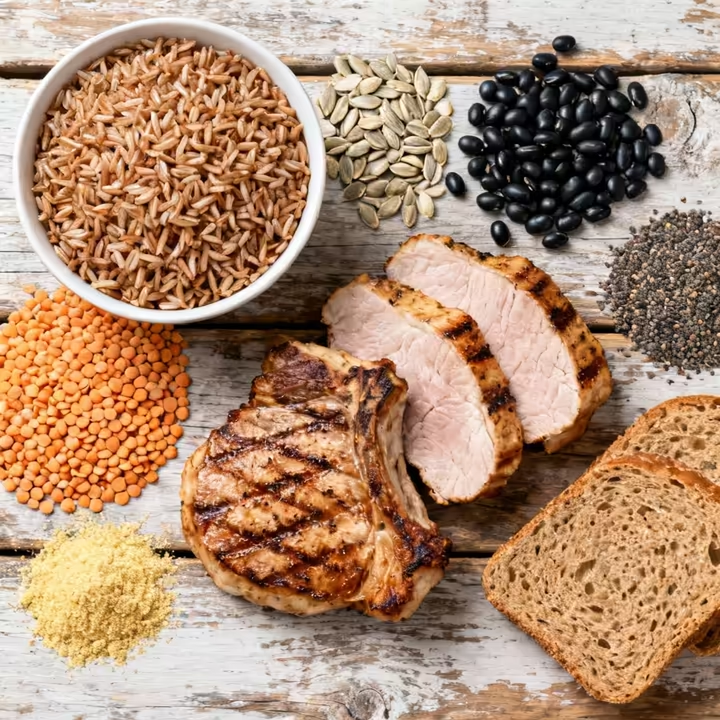
The Discovery of Thiamine
The Beriberi Mystery
The story of thiamine starts with beriberi, a nasty disease that plagued Asia in the late 19th century. 2 Its name basically means "weakness," and it caused extreme fatigue, muscle wasting, nerve damage, and heart failure. The big clue was tied to a new invention, the steam-powered rice mill.
These mills efficiently polished rice, stripping off the outer bran and germ to make fluffy white rice. This new rice looked fancier and lasted longer, but it was missing something vital. 5 Millions of people eating it as a staple food were unknowingly setting themselves up for disaster.
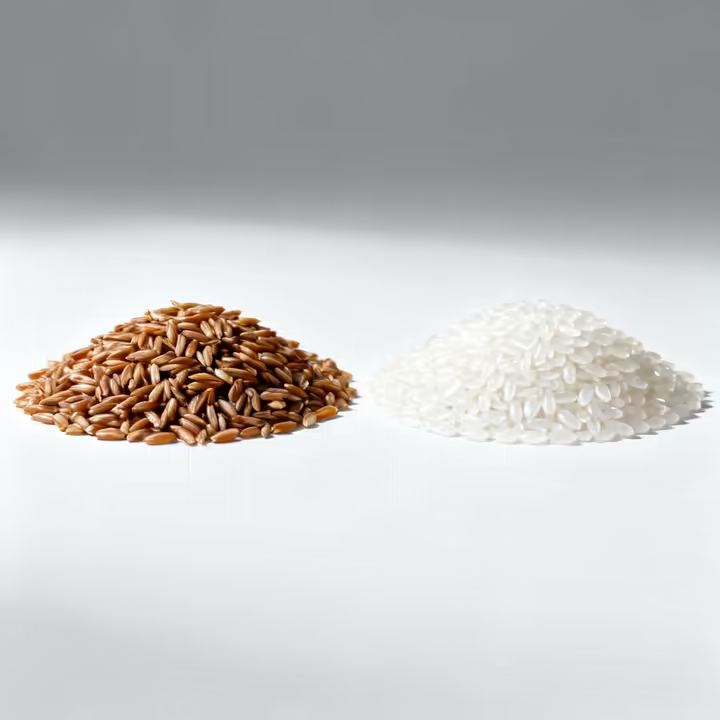
Finding the Clues
In the 1880s, a Japanese naval surgeon named Kanehiro Takaki noticed his sailors, who lived on white rice, were getting beriberi like crazy. 5 He guessed it was their diet and swapped some of the rice for barley, meat, and veggies. Bam... beriberi was virtually wiped out in the Japanese Navy. 4
Around the same time, a Dutch doctor, Christiaan Eijkman, saw something weird in his lab chickens. The ones fed leftover polished rice got a paralysis that looked just like human beriberi. 2 When their diet switched back to unpolished rice, they got better.
Eijkman thought there was a poison in white rice that was neutralized by something in the bran. His colleague, Gerrit Grijns, correctly figured out that the bran just contained an essential substance that white rice was missing. 2
Naming the Vitamin
In 1912, biochemist Casimir Funk isolated a substance from rice bran that he thought was the cure. He called it "vitamine," a mix of "vital" and "amine." 5 His sample was probably a different vitamin (B3), but the name stuck (minus the "e").
The real deal was finally isolated in 1926 by Barend Jansen and Willem Donath. 2 Its structure was mapped out and it was first synthesized in 1936 by Robert R. Williams, who named it thiamine because it contained sulfur. 4 This kicked off a new era in nutrition, allowing us to fortify foods like flour and prevent deficiency.
How Thiamine Works in Your Body
So what does thiamine actually do? Inside your cells, it gets converted into its active form, thiamine pyrophosphate (TPP). 4 Think of TPP as a tiny "helper molecule" or coenzyme for a few super-important jobs. 12
The Energy Gatekeeper
TPP's main job is unlocking the energy stored in carbohydrates. 9 After your cells break glucose down into pyruvate, TPP steps in as a gatekeeper for the next stage, the Krebs cycle, which is where the real energy production happens. TPP helps a group of enzymes called the pyruvate dehydrogenase complex (PDC) convert pyruvate into acetyl-CoA, the main fuel for the Krebs cycle. 13
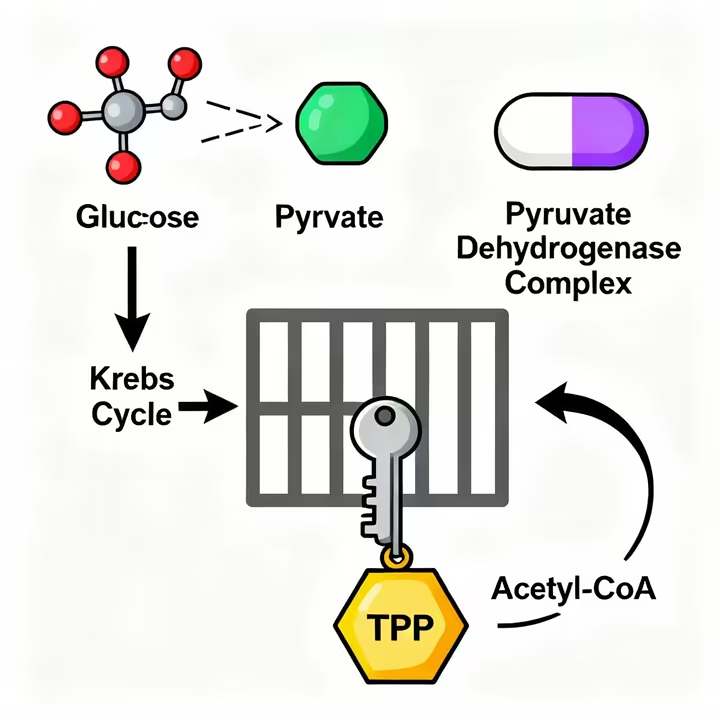
Without enough TPP, that gate slams shut. Pyruvate can't get through, so it builds up with its byproduct, lactate, which is toxic in high amounts (a condition called lactic acidosis). 16 The Krebs cycle starves for fuel, and your cells' ability to make energy plummets.
More Than Just Energy
TPP also helps another enzyme inside the Krebs cycle, the α-ketoglutarate dehydrogenase complex, which is essential for keeping the whole energy-making process running smoothly. 4 But it has another key role outside of pure energy production, in a process called the pentose phosphate pathway (PPP). 11
Here, TPP helps an enzyme called transketolase do two things. First, it makes ribose-5-phosphate, the sugar that forms the backbone of your DNA and RNA. 11 Second, it produces NADPH, a molecule needed to make fatty acids and to regenerate glutathione, one of your body's most powerful antioxidants. 21
Why Your Brain Needs It
This explains why thiamine is so critical for your brain. The brain is an energy hog, burning through about 20% of your body's oxygen to metabolize glucose. 24 Any disruption to energy production has immediate effects on brain function.
Plus, the acetyl-CoA that TPP helps create is the starting point for acetylcholine, a neurotransmitter vital for memory and nerve-muscle communication. 4 The NADPH it helps generate is essential for building the myelin sheath, the fatty insulation around your nerve fibers that allows them to send signals quickly and efficiently. 1
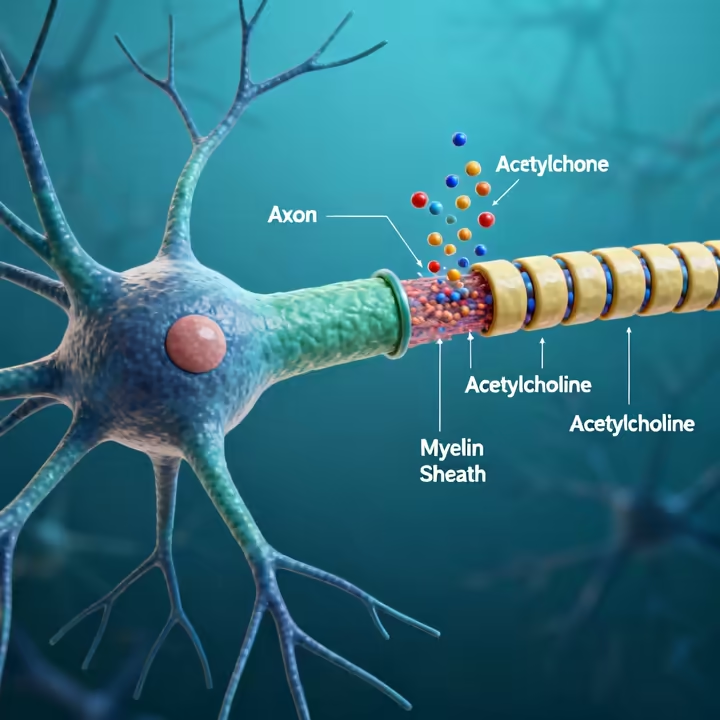
What Thiamine Does For You
Because of its deep biochemical roles, having enough thiamine benefits your whole body. It's especially felt in the parts with the highest energy demands, like the brain, heart, and digestive system. Keeping your thiamine levels up is key for overall health.
Brain Power
Your brain runs on a constant supply of glucose-derived energy, a process that depends entirely on thiamine. It both fuels your thoughts and helps build the structures for nerve function. 14 By supporting the myelin sheath and neurotransmitters, thiamine keeps communication lines clear throughout the nervous system.
Good thiamine levels are linked to better memory, concentration, and a stable mood, which is why it's sometimes called the "morale vitamin." 29 Even a small shortage can cause confusion, irritability, and memory problems. 25
A Healthy Heart
The heart is a muscle that never stops, beating over 100,000 times a day. All that work requires a massive amount of ATP energy, generated by the thiamine-dependent Krebs cycle. 36 Thiamine keeps the energy pipeline open, supporting proper heart muscle function. 34
When thiamine levels drop, the heart struggles to make energy. This can lead to an enlarged heart and, in severe cases, the heart failure seen in wet beriberi. 34
Smooth Digestion
Thiamine also helps your digestive system. It supplies the energy needed for the smooth muscles in your gut to contract and move food along (a process called peristalsis). 26 It's also involved in regulating the secretion of hydrochloric acid in the stomach.
This stomach acid is crucial for breaking down protein and killing germs in your food. A thiamine deficiency can lead to low stomach acid, causing problems like bloating and indigestion. 26
Immune Support
Thiamine supports your immune system, mainly through its role in producing NADPH. That NADPH is needed to recharge glutathione, your body's "master antioxidant." 16 Glutathione protects all your cells, including immune cells, from damage caused by oxidative stress. 21
Getting Thiamine on Your Plate
For most people, getting enough thiamine just means making smart food choices. It's found in lots of whole foods, but you have to know what to look for... and how to cook it.

Grains (The Good Kind)
Whole grains like brown rice, oatmeal, whole-wheat bread, and barley are fantastic sources. 6 The thiamine is packed into the outer layers, the bran and the germ. 31
In contrast, refined grains like white rice and white flour have had those nutritious layers milled away. 45 To fix this, many countries require that refined grain products be "enriched" with thiamine and other B vitamins that were stripped out. 31
Proteins, Nuts, and Seeds
Lots of protein-rich foods have plenty of thiamine. Pork is a real champion here, as it's one of the richest sources you can find. 43 Beef, salmon, and tuna are also good choices. 47
If you're eating plant-based, legumes are your friend, especially black beans, lentils, and green peas. 11 Nuts and seeds are great too, with sunflower seeds being a standout. 44 Nutritional yeast is another super-concentrated source often used in vegan cooking. 48
The Catch: Cooking and Anti-Nutrients
Just because it's in the food doesn't mean your body gets it all. Thiamine is water-soluble and sensitive to heat, so how you cook matters. 49 Boiling can cause up to 60% of the thiamine to leach out into the water, so if you dump that water, you're dumping the vitamin too. 52 Steaming, stir-frying, or microwaving are much better at keeping it in the food.
Some foods even work against you. Raw fish and shellfish contain enzymes called thiaminases that destroy thiamine (cooking deactivates them). 1 And compounds called polyphenols, like the tannins in tea and coffee, can bind to thiamine in your gut, preventing you from absorbing it. 54 So, drinking tea or coffee with your meals can reduce how much thiamine you get.
When You Don't Get Enough
When your thiamine supply runs low, the body's metabolic engine starts to fail. Deficiency can happen for several reasons and shows up as a range of symptoms affecting your most energy-hungry tissues.
What Causes Deficiency?
The simplest cause is not eating enough thiamine-rich foods, a problem seen in places where polished rice is the main food source. 1 In developed countries, though, the most common cause is chronic alcohol use. 1 Alcohol harms thiamine levels by reducing food intake, blocking absorption, and interfering with its storage and use in the body. 55
Other causes include conditions that impair nutrient absorption, like Crohn's disease or bariatric surgery. 1 Anything that revs up your metabolism, like pregnancy or persistent fever, also increases your need for thiamine. 57
Dry Beriberi: Nerve Damage
This is the neurological form of severe thiamine deficiency. 1 It features a symmetrical peripheral neuropathy, which means it affects nerves on both sides of your body, usually starting in your feet and hands. 57
Patients feel a painful burning or "pins and needles" sensation, numbness, and progressive muscle weakness. This happens because the myelin sheath insulation and the nerve fibers themselves start to break down. 62
Wet Beriberi: Heart Problems
Wet beriberi primarily targets the cardiovascular system. 1 The heart can't produce enough energy, which leads to the widening of blood vessels. To keep blood pressure up, the heart has to pump faster and harder, leading to high-output heart failure. 18
Symptoms include a rapid heart rate (tachycardia), shortness of breath, and significant swelling (edema) in the lower legs. An acute form called Shoshin beriberi can cause a total circulatory collapse and death if not treated immediately. 18
Wernicke-Korsakoff Syndrome: Brain Failure
This is the most severe neurological result of thiamine deficiency, usually seen in people with chronic alcohol use disorder. 14 It's a two-stage illness. The first stage is Wernicke encephalopathy, an acute and life-threatening condition. 68
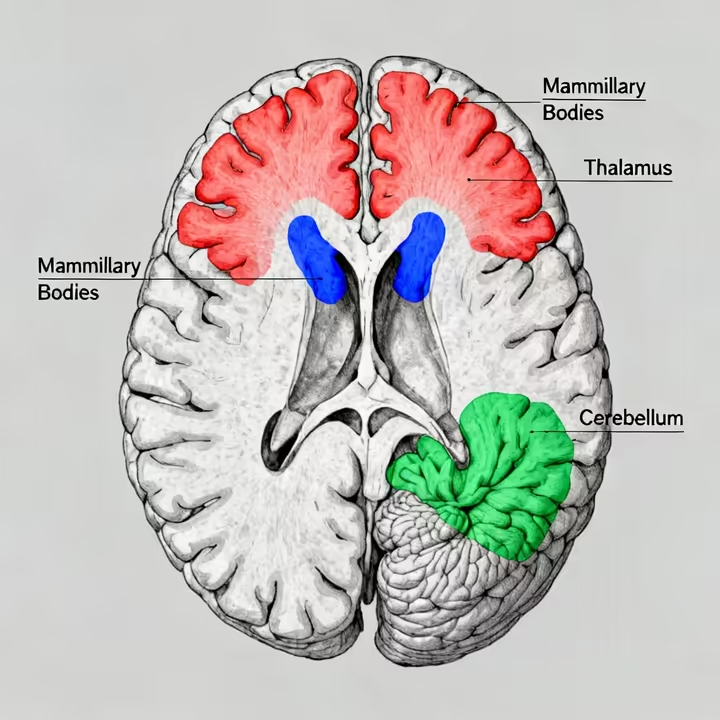
It has a classic trio of symptoms, profound confusion, an unsteady, staggering walk (ataxia), and paralysis or weakness of the eye muscles (ophthalmoplegia). 66 It's a medical emergency that requires immediate thiamine. If not treated, it can progress to the second stage, Korsakoff psychosis. 68
Korsakoff psychosis involves severe, often irreversible brain damage. Its hallmark is profound amnesia, both the inability to form new memories and the loss of old ones. A strange feature is confabulation, where the person unconsciously invents false memories to fill in the gaps. 68
Doses, Guidelines, and Supplements
So how much do you need? For most people, a good diet is enough. But in some cases, supplements are essential.
Daily Recommendations
The Recommended Dietary Allowances (RDA) are guidelines for how much thiamine healthy people need each day. For adult men, it's 1.2 mg/day, and for adult women, it's 1.1 mg/day. 71 Needs go up during pregnancy and lactation, to 1.4 mg/day, to support both mother and baby. 11
| Life Stage | Age | Males (mg/day) | Females (mg/day) |
|---|---|---|---|
| Infants (AI*) | 0–6 months | 0.2 | 0.2 |
| Infants (AI*) | 7–12 months | 0.3 | 0.3 |
| Children | 1–3 years | 0.5 | 0.5 |
| Children | 4–8 years | 0.6 | 0.6 |
| Adolescents | 9–13 years | 0.9 | 0.9 |
| Adolescents | 14–18 years | 1.2 | 1.0 |
| Adults | 19+ years | 1.2 | 1.1 |
| Pregnancy | All ages | - | 1.4 |
| Lactation | All ages | - | 1.4 |
| *Adequate Intake (AI) |
Regular vs. Super-Charged Thiamine
Supplementation is key for treating diagnosed deficiencies like beriberi. It's also used to prevent problems in high-risk groups, like people with alcohol use disorder or those who've had bariatric surgery. 73 The most common supplement form is thiamine hydrochloride. 38
It's effective, but your gut's ability to absorb it can be limited, especially in people who need it most. 75 To get around this, scientists developed a synthetic, fat-soluble version called benfotiamine. 29
Because it's fat-soluble, benfotiamine gets absorbed much more easily and results in significantly higher levels of thiamine inside your cells. 29 This makes it a great option for quickly fixing a deficiency, especially when gut absorption is a problem. 77
Safety and Side Effects
The good news is that thiamine is very safe. It's a water-soluble vitamin, so your body doesn't store large amounts of it, you just pee out any excess. 13 Because of this, there's no official "Tolerable Upper Intake Level" (UL) for thiamine. 13
Is It Safe?
When taken as a pill, side effects are rare and usually minor, maybe some mild itching, nausea, or a feeling of warmth. 34 A severe allergic reaction (anaphylaxis) is possible but extremely rare. This is almost always seen with repeated intravenous (IV) injections, not with oral supplements. 84
The only real reason to avoid thiamine is if you have a known allergy to it. 73 Its effect on blood pressure is complicated, it is influenced by a person's underlying health, not a simple up-or-down effect. 91
Drug Interactions
The most important interaction to know about is with diuretics, especially loop diuretics like furosemide. 43 These drugs, often used for heart failure, make you urinate more, which also flushes out water-soluble vitamins like thiamine. 98
Long-term diuretic use can lead to a chronic thiamine deficiency. 100 This is a serious risk, as the drug used to treat heart failure can deplete a nutrient that is essential for the heart's energy, potentially making things worse. Other medications, like the chemo drug fluorouracil and the diabetes drug metformin, can also interfere with thiamine. 104
The Final Word on Thiamine
From its discovery as the first vitamin to its role at the center of metabolism, thiamine is a seriously important micronutrient. It's the spark plug for the engine of life, turning food into the energy that powers every single cell in your body. 1
For most of us, the best way to get enough thiamine is from a dinner plate, not a pill bottle. A balanced diet rich in whole grains, legumes, lean meats, and nuts is the way to go. 6 This "food first" approach is always the best bet.
But in certain situations, like with chronic health conditions or some medications, supplementation is a vital tool. Always talk to a healthcare provider to figure out what's right for you. This ensures the vital spark of thiamine keeps fueling a healthy life.
Works cited
- Vitamin B1 (Thiamine) Deficiency - StatPearls - NCBI Bookshelf, https://www.ncbi.nlm.nih.gov/books/NBK537204/
- The Vitamin B Complex: A National Historic Chemical Landmark, https://www.acs.org/education/whatischemistry/landmarks/vitamin-b-complex.html
- pubchem.ncbi.nlm.nih.gov, https://pubchem.ncbi.nlm.nih.gov/compound/Thiamine#:~:text=It%20is%20a%20primary%20alcohol,of%20a%20thiamine(2%2B).&text=Thiamine%20or%20thiamin%2C%20also%20known,water%20and%20insoluble%20in%20alcohol.
- Vitamin B1 (Thiamine) - Medicine LibreTexts, https://med.libretexts.org/Courses/Dominican_University/DU_Bio_1550%3A_Nutrition_(LoPresto)/7%3A_Vitamins/7.3%3A_Water_Soluble_Vitamins/Vitamin_B1
- History of a Vitamin - The Hospitalist, https://www.the-hospitalist.org/hospitalist/article/123237/history-vitamin
- Thiamine Content In Foods - Consensus Academic Search Engine, https://consensus.app/questions/thiamine-content-in-foods/
- Thiamine Deficiency, http://thiamine.dnr.cornell.edu/
- Vitamin B1 | RIKEN, https://www.riken.jp/en/about/history/story/b1/index.html
- medlineplus.gov, https://medlineplus.gov/ency/article/002401.htm#:~:text=Function&text=Thiamin%20(vitamin%20B1)%20helps%20the,and%20conduction%20of%20nerve%20signals.
- About thiamine - NHS, https://www.nhs.uk/medicines/thiamine-vitamin-b1/about-thiamine/
- Thiamin | Linus Pauling Institute | Oregon State University, https://lpi.oregonstate.edu/mic/vitamins/thiamin
- Thiamine Properties - Cornell University, http://thiamine.dnr.cornell.edu/Thiamine_properties.html
- Thiamin - PMC, https://pmc.ncbi.nlm.nih.gov/articles/PMC5347104/
- Thiamin: MedlinePlus Medical Encyclopedia, https://medlineplus.gov/ency/article/002401.htm
- Thiamine Biochemistry - Cornell University, http://thiamine.dnr.cornell.edu/Thiamine_biochemistry.html
- Hiding in Plain Sight: Modern Thiamine Deficiency - MDPI, https://www.mdpi.com/2073-4409/10/10/2595
- Carbohydrate metabolism and role of thiamine. The inability to use the... - ResearchGate, https://www.researchgate.net/figure/Carbohydrate-metabolism-and-role-of-thiamine-The-inability-to-use-the-Krebs-cycle-is-the_fig2_276850562
- Wet beriberi with multiple organ failure remarkably reversed by thiamine administration: A case report and literature review - PMC, https://pmc.ncbi.nlm.nih.gov/articles/PMC5851725/
- www.mdpi.com, https://www.mdpi.com/2072-6643/17/13/2206#:~:text=In%20mitochondria%2C%20thiamine%20diphosphate%20acts,stages%20of%20aerobic%20cellular%20respiration.
- Transketolase - Wikipedia, https://en.wikipedia.org/wiki/Transketolase
- Thiamine (Vitamin B1)—An Essential Health Regulator - MDPI, https://www.mdpi.com/2072-6643/17/13/2206
- journals.plos.org, https://journals.plos.org/plosone/article?id=10.1371/journal.pone.0221016#:~:text=Transketolase%20(TKT)%20is%20a%20thiamine,as%20a%20substrate%20for%20ROS
- The critical role of thiamine in carbohydrate metabolism and its... - ResearchGate, https://www.researchgate.net/figure/The-critical-role-of-thiamine-in-carbohydrate-metabolism-and-its-connection-with-GSH_fig1_303537663
- The importance of thiamine (vitamin B1) in humans - PMC - PubMed Central, https://pmc.ncbi.nlm.nih.gov/articles/PMC10568373/
- Neurological, Psychiatric, and Biochemical Aspects of Thiamine Deficiency in Children and Adults - Frontiers, https://www.frontiersin.org/journals/psychiatry/articles/10.3389/fpsyt.2019.00207/full
- Thiamine, gastrointestinal beriberi and acetylcholine ... - Frontiers, https://www.frontiersin.org/journals/nutrition/articles/10.3389/fnut.2025.1541054/full
- Nutrition, Myelin, and Nervous System Health - OptimalDX, https://www.optimaldx.com/research-blog/nutrition-myelin-and-nervous-system-health
- Myelin Sheath: What It Is, Purpose & Function - Cleveland Clinic, https://my.clevelandclinic.org/health/body/22974-myelin-sheath
- Thiamine and benfotiamine: Focus on their therapeutic potential - PMC, https://pmc.ncbi.nlm.nih.gov/articles/PMC10682628/
- Vitamin B1 (Thiamin): Foods, benefits, and deficiency symptoms, https://www.medicalnewstoday.com/articles/219545
- Get to Know Grains: Why You Need Them, and What to Look For ..., https://www.heart.org/en/healthy-living/healthy-eating/eat-smart/nutrition-basics/whole-grains-refined-grains-and-dietary-fiber
- Cognitive Function In Depth | Linus Pauling Institute, https://lpi.oregonstate.edu/mic/health-disease/cognitive-function
- Vitamin B1 (thiamine) and dementia - PMC - PubMed Central, https://pmc.ncbi.nlm.nih.gov/articles/PMC4846521/
- Vitamin B1 (Thiamine): What It Is, Foods and Health Benefits - WebMD, https://www.webmd.com/vitamins-and-supplements/health-benefits-of-vitamin-b-1
- Thiamine - vitamin B1 for the cardiovascular system and blood vessels - rubyni, https://rubyni.com/en/wissen/thiamine
- Thiamine treatment preserves cardiac function against ischemia injury via maintaining mitochondrial size and ATP levels, https://journals.physiology.org/doi/abs/10.1152/japplphysiol.00578.2020
- www.mdpi.com, https://www.mdpi.com/1422-0067/26/7/3090#:~:text=Thiamine%20deficiency%20is%20thought%20to,%2C%20and%20depression%20%5B11%5D.
- Thiamine hydrochloride | DrugBank Online, https://go.drugbank.com/salts/DBSALT000205
- Why we need Thiamine (B1) · Blog of Michaela - Nutrium, https://nutrium.com/p/Michaela/blog/44f1-why-we-need-thiamine-%2528b1%2529
- Antioxidant Properties of Thiamine | Request PDF - ResearchGate, https://www.researchgate.net/publication/12153907_Antioxidant_Properties_of_Thiamine
- Thiamine in Lipid Systems vs. the Antioxidant Activity of Epigallocatechin Gallate and Caffeine - MDPI, https://www.mdpi.com/2071-1050/13/9/4644
- BENEFITS OF VITAMIN B1 THIAMINE - Rejuvii, https://www.rejuvii.com/post/2019/02/12/10-amazing-benefits-of-vitamin-b1-thiamine
- Vitamin B1 (Thiamine) - StatPearls - NCBI Bookshelf, https://www.ncbi.nlm.nih.gov/books/NBK482360/
- Thiamin - Health Professional Fact Sheet - NIH Office of Dietary Supplements, https://ods.od.nih.gov/factsheets/Thiamin-HealthProfessional/
- MyPlate.gov | Grains Group – One of the Five Food Groups, https://www.myplate.gov/eat-healthy/grains
- Whole grains: Hearty options for a healthy diet - Mayo Clinic, https://www.mayoclinic.org/healthy-lifestyle/nutrition-and-healthy-eating/in-depth/whole-grains/art-20047826
- Vitamin B1 foods: Naturally high and enriched options - Medical News Today, https://www.medicalnewstoday.com/articles/vitamin-b1-foods
- Food Sources of Thiamin (Vitamin B1), https://niagaranorthfht.ca/wp-content/uploads/2020/05/Copy-of-thiamine.pdf
- pmc.ncbi.nlm.nih.gov, https://pmc.ncbi.nlm.nih.gov/articles/PMC8451796/#:~:text=Thiamine%20is%20water%E2%80%90soluble%20and,it%20may%20undergo%20thermal%20degradation.&text=Cooking%20techniques%20that%20minimize%20water,result%20in%20higher%20thiamine%20retention.
- Cooking Your Food Without Losing Nutrients - Yuka, https://yuka.io/en/cooking-methods-health/
- Thiamine Partitioning and Retention in Cooked Rice and Pasta Products - Cereals & Grains Association, https://www.cerealsgrains.org/publications/cc/backissues/1987/Documents/64_116.pdf
- How Cooking Affects the Nutrient Content of Foods - Healthline, https://www.healthline.com/nutrition/cooking-nutrient-content
- Thiamine - Sources, Supports and Fun Facts - Revive Active, https://ie.reviveactive.com/blogs/blogs/facts-about-thiamine
- Beriberi caused by antithiamin factors in food and its prevention - PubMed, https://pubmed.ncbi.nlm.nih.gov/7044221/
- Thiamin Deficiency - Disorders of Nutrition - MSD Manual Consumer Version, https://www.msdmanuals.com/home/disorders-of-nutrition/vitamins/thiamin-deficiency
- Causes of thiamine deficiency - Cornell University, http://thiamine.dnr.cornell.edu/Thiamine_causes.html
- Thiamin Deficiency - Nutritional Disorders - Merck Manual Professional Edition, https://www.merckmanuals.com/professional/nutritional-disorders/vitamin-deficiency-dependency-and-toxicity/thiamin-deficiency
- Thiamin Deficiency - Disorders of Nutrition - Merck Manual Consumer Version, https://www.merckmanuals.com/home/disorders-of-nutrition/vitamins/thiamin-deficiency
- What are B1 deficiency symptoms? 9 signs you might need more thiamine, https://www.bswhealth.com/blog/12-signs-you-might-have-a-thiamine-deficiency
- www.ncbi.nlm.nih.gov, https://www.ncbi.nlm.nih.gov/books/NBK537204/#:~:text=With%20prolonged%20thiamine%20deficiency%2C%20patients,double%20vision%2C%20and%20memory%20loss.
- Pathophysiology, prevention, and treatment of beriberi after gastric surgery | Nutrition Reviews | Oxford Academic, https://academic.oup.com/nutritionreviews/article/78/12/1015/5835520
- Thiamine deficiency - Wikipedia, https://en.wikipedia.org/wiki/Thiamine_deficiency
- Thiamine Deficiency - ClinPGx, https://www.clinpgx.org/disease/PA445837
- Beriberi: MedlinePlus Medical Encyclopedia, https://medlineplus.gov/ency/article/000339.htm
- Vitamin B1 deficiency - Symptoms, diagnosis and treatment - BMJ Best Practice, https://bestpractice.bmj.com/topics/en-gb/633
- Wernicke-Korsakoff Syndrome - StatPearls - NCBI Bookshelf, https://www.ncbi.nlm.nih.gov/books/NBK430729/
- Wernicke–Korsakoff syndrome - Wikipedia, https://en.wikipedia.org/wiki/Wernicke%E2%80%93Korsakoff_syndrome
- Wet Brain from Alcohol: Wernicke-Korsakoff Syndrome (WKS) - American Addiction Centers, https://americanaddictioncenters.org/alcohol/risks-effects-dangers/wernicke-korsakoff-syndrome
- Korsakoff Syndrome - StatPearls - NCBI Bookshelf, https://www.ncbi.nlm.nih.gov/books/NBK539854/
- www.ncbi.nlm.nih.gov, https://www.ncbi.nlm.nih.gov/books/NBK114331/#:~:text=The%20method%20used%20to%20estimate,1.1%20mg%2Fday%20for%20women.
- Dietary Reference Intakes for Thiamin, Riboflavin, Niacin, Vitamin, https://www.ncbi.nlm.nih.gov/books/NBK114331/
- B vitamins and folic acid - - - Vitamins and minerals - NHS, https://www.nhs.uk/conditions/vitamins-and-minerals/vitamin-b/
- Thiamine (Vitamin B1) : MedlinePlus Drug Information, https://medlineplus.gov/druginfo/meds/a682586.html
- Thiamine: Uses, Interactions, Mechanism of Action - DrugBank, https://go.drugbank.com/drugs/DB00152
- Thiamine and Other Supplements - Guidelines for the Treatment of Alcohol Problems, https://alcoholtreatmentguidelines.com.au/chapter-8-alcohol-withdrawal/thiamine-and-other-supplements
- Thiamine Pyrophosphate Biosynthesis and Transport in the Nematode Caenorhabditis elegans - PMC - PubMed Central, https://pmc.ncbi.nlm.nih.gov/articles/PMC1448845/
- BENFOTIAMINE: Overview, Uses, Side Effects, Precautions, Interactions, Dosing and Reviews - WebMD, https://www.webmd.com/vitamins/ai/ingredientmono-1574/benfotiamine
- Benfotiamine with Thiamin - Country Life Vitamins, https://countrylifevitamins.com/products/benfotiamine
- Pharmacokinetic study of benfotiamine and the bioavailability assessment compared to thiamine hydrochloride - PubMed, https://pubmed.ncbi.nlm.nih.gov/24399744/
- How and when to take thiamine - NHS, https://www.nhs.uk/medicines/thiamine-vitamin-b1/how-and-when-to-take-thiamine/
- Opinion of the SCF on the Tolerable Upper Intake Level of Vitamin B1 - Food Safety, https://food.ec.europa.eu/system/files/2020-12/sci-com_scf_out93_en.pdf
- Thiamine Uses, Side Effects & Warnings - Drugs.com, https://www.drugs.com/mtm/thiamine.html
- Thiamine side effects and how to avoid them - SingleCare, https://www.singlecare.com/blog/thiamine-side-effects/
- Thiamine Side Effects: Common, Severe, Long Term - Drugs.com, https://www.drugs.com/sfx/thiamine-side-effects.html
- pmc.ncbi.nlm.nih.gov, https://pmc.ncbi.nlm.nih.gov/articles/PMC3794222/#:~:text=Anaphylactic%20reactions%20to%20parenteral%20thiamine,identified%20in%20the%20mid%2D1990s.&text=These%20allergic%20reactions%20are%20extremely,pairs%20of%20ampoules%20of%20Pabrinex.
- Anaphylactic shock and cardiac arrest caused by thiamine infusion - PMC - PubMed Central, https://pmc.ncbi.nlm.nih.gov/articles/PMC3736362/
- Side effects of thiamine - NHS, https://www.nhs.uk/medicines/thiamine-vitamin-b1/side-effects-of-thiamine/
- Evaluation of the safety of 500 mg intravenous push thiamine at a tertiary academic medical center - PMC - PubMed Central, https://pmc.ncbi.nlm.nih.gov/articles/PMC10306149/
- Associations of Serum Thiamine Levels with Blood Pressure Among Middle-Aged and Elderly Women in Eastern China - MDPI, https://www.mdpi.com/2072-6643/17/13/2210
- Vitamin B1 supplementation lowers blood pressure in people with hyperglycaemia, https://www.blackmoresinstitute.org/news/vitamin-b1-supplementation-lowers-blood-pressure-in-people-with-hyperglycaemia
- Vitamin B1 Side Effects Blood Pressure - Consensus Academic Search Engine, https://consensus.app/questions/vitamin-b1-side-effects-blood-pressure/
- Who can and cannot take thiamine - NHS, https://www.nhs.uk/medicines/thiamine-vitamin-b1/who-can-and-cannot-take-thiamine/
- Thiamine HCl (Vitamin B1) Oral: Uses, Side Effects, Interactions, Pictures, Warnings & Dosing - WebMD, https://www.webmd.com/drugs/2/drug-3981/thiamine-hcl-vitamin-b1-oral/details
- Angioneurotic oedema secondary to oral thiamine - PMC, https://pmc.ncbi.nlm.nih.gov/articles/PMC3794222/
- Thiamine Tablets - Cleveland Clinic, https://my.clevelandclinic.org/health/drugs/19808-thiamine-tablets
- Thiamine: Side Effects, Uses, Dosage, Interactions, Warnings - RxList, https://www.rxlist.com/thiamine/generic-drug.htm
- Loop diuretics (drug interactions) | Research Starters - EBSCO, https://www.ebsco.com/research-starters/health-and-medicine/loop-diuretics-drug-interactions
- Diuretics and vitamin B1: are diuretics a risk factor for thiamin malnutrition? - SciSpace, https://scispace.com/pdf/diuretics-and-vitamin-b1-are-diuretics-a-risk-factor-for-5eh3qg6pzx.pdf
- Diuretic use: A risk factor for subclinical thiamine deficiency in elderly patients | Request PDF - ResearchGate, https://www.researchgate.net/publication/12476715_Diuretic_use_A_risk_factor_for_subclinical_thiamine_deficiency_in_elderly_patients
- Water Pills for High Blood Pressure Cause Vitamin B1 Deficiencies - Natural Eye Care, https://www.naturaleyecare.com/articles/water-pills-for-high-blood-pressure.asp
- Loop Diuretic Therapy, Thiamine Balance, and Heart Failure | Request PDF - ResearchGate, https://www.researchgate.net/publication/6165257_Loop_Diuretic_Therapy_Thiamine_Balance_and_Heart_Failure
- Taking thiamine with other medicines and herbal supplements - NHS, https://www.nhs.uk/medicines/thiamine-vitamin-b1/taking-thiamine-with-other-medicines-and-herbal-supplements/
- Thiamine (oral route, injection route) - Side effects & dosage - Mayo Clinic, https://www.mayoclinic.org/drugs-supplements/thiamine-oral-route-injection-route/description/drg-20066328
- THIAMINE (VITAMIN B1): Overview, Uses, Side Effects, Precautions, Interactions, Dosing and Reviews - WebMD, https://www.webmd.com/vitamins/ai/ingredientmono-965/thiamine-vitamin-b1
- Drug–nutrient interactions: discovering prescription drug inhibitors of the thiamine transporter ThTR-2 (SLC19A3) - PubMed Central, https://pmc.ncbi.nlm.nih.gov/articles/PMC6944527/